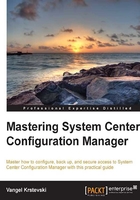
Chapter 1. Introduction to System Center Configuration Manager 2012 R2
System Center Configuration Manager, formerly named Systems Management Server, is a Microsoft product that is a part of the System Center Suite. It provides management capabilities for large groups of different device types such as workstations, servers, laptops, and mobile devices. These devices can run on different operating systems such as Windows, Windows Embedded, Linux, UNIX, Mac OS X, Windows Phone, iOS, Symbian OS, and Android. Not only does it provide management of such device types, but it also provides these features: remote control for some of the devices' OSes, software distribution, patches and patch management, operating system deployment, and creating devices' software and hardware inventory. So, System Center Configuration Manager provides both efficient and effective IT services with the help of scalable software deployment, devices compliance management, as well as the asset management of discovered hardware and software resources.
System Center Configuration Manager helps with the control of its IT infrastructure and assets. The asset management functionality provides IT engineers with a detailed image of the software and hardware inventory, which clients are using them, and where they are located in the infrastructure. This asset management functionality provides reports that help enterprises to optimize their hardware and software usage and take better strategic decisions regarding software licenses and compliance with these licenses.